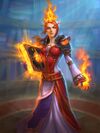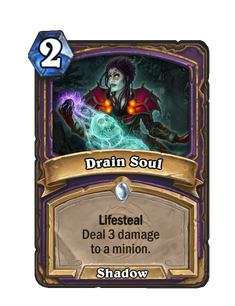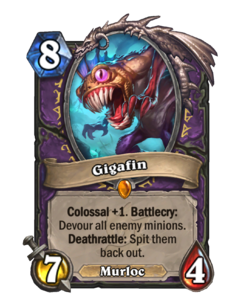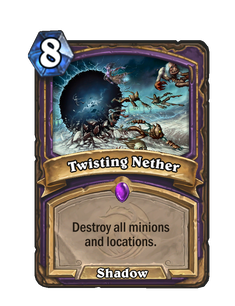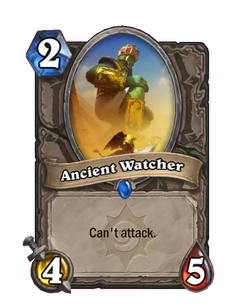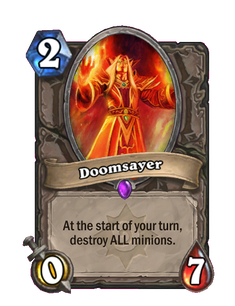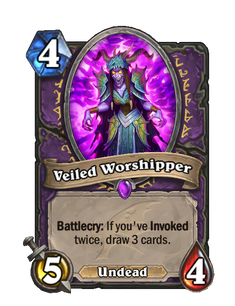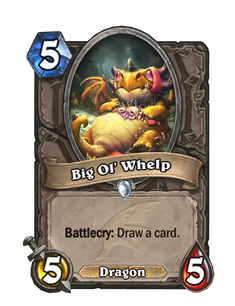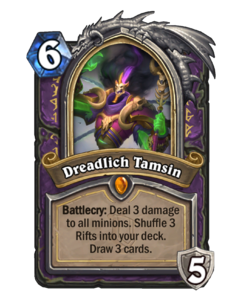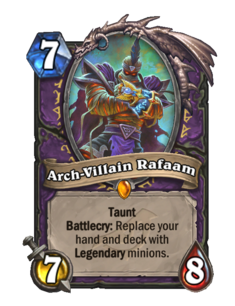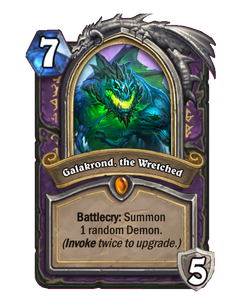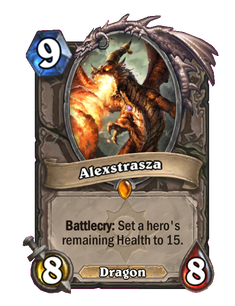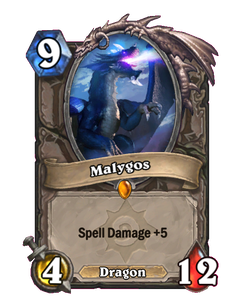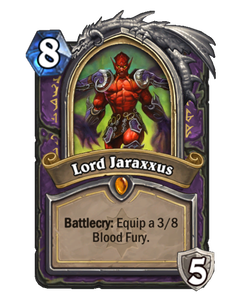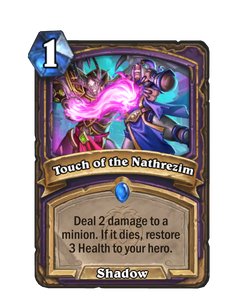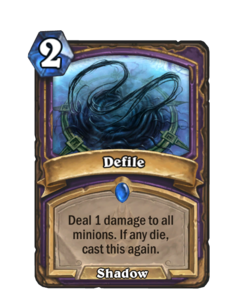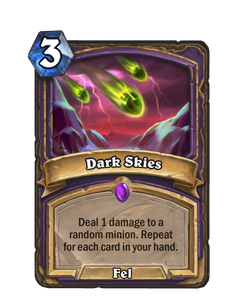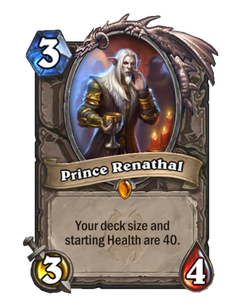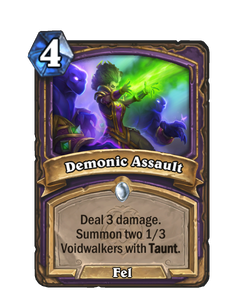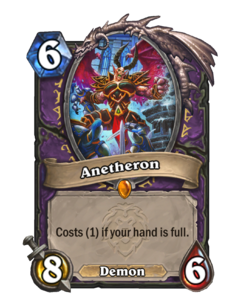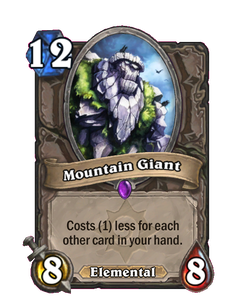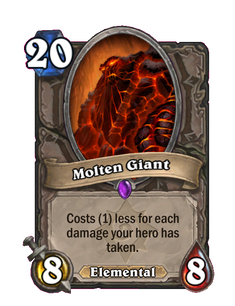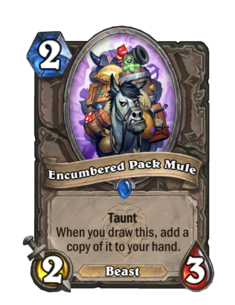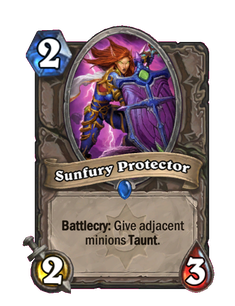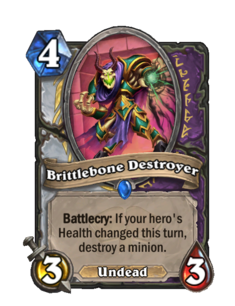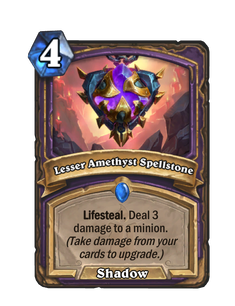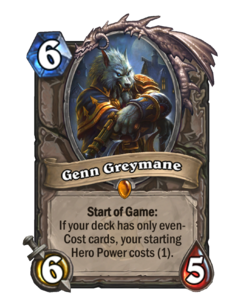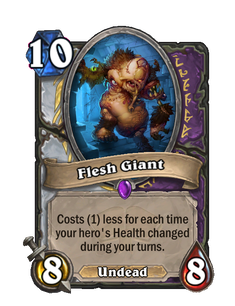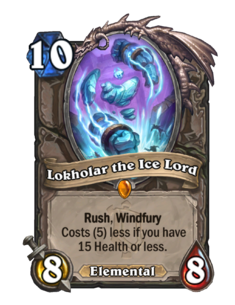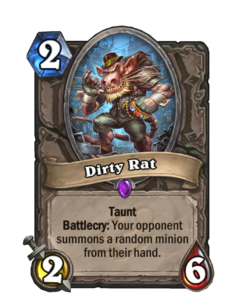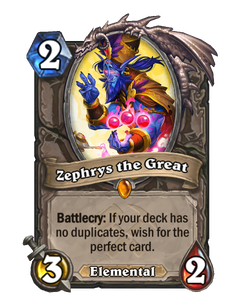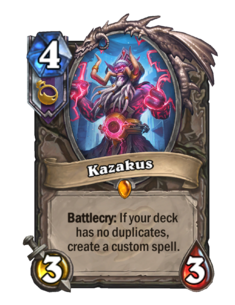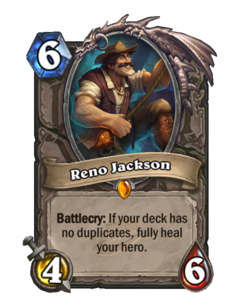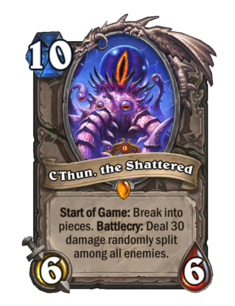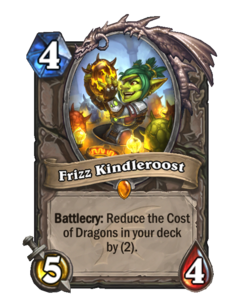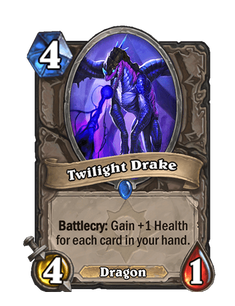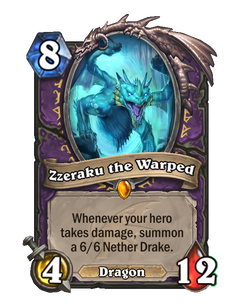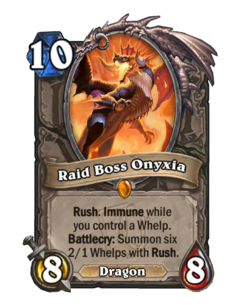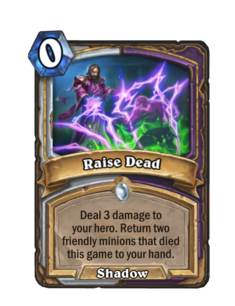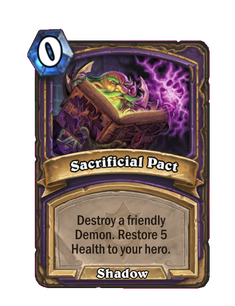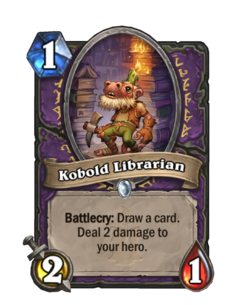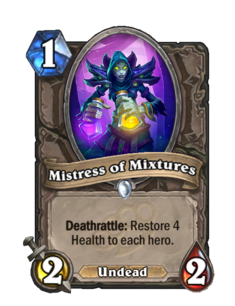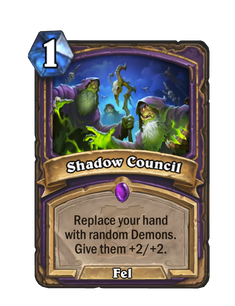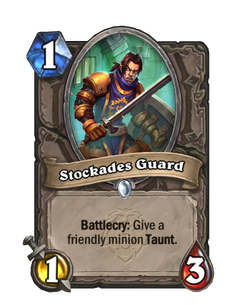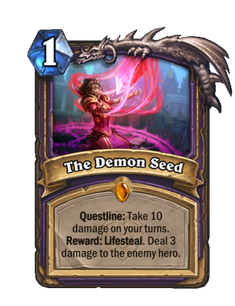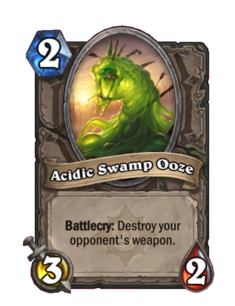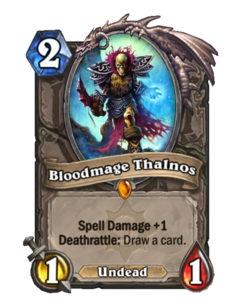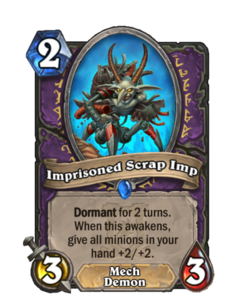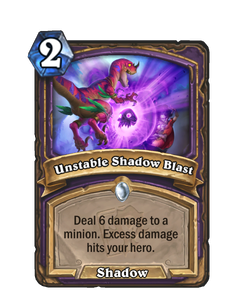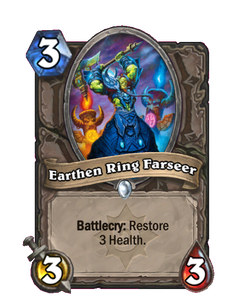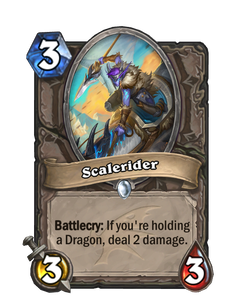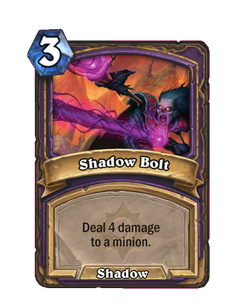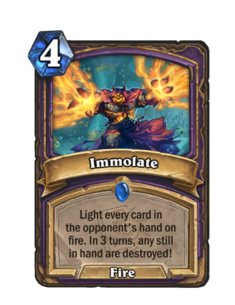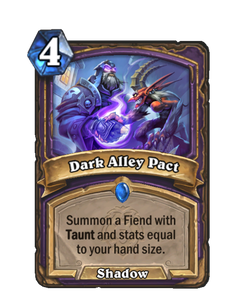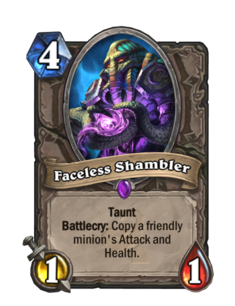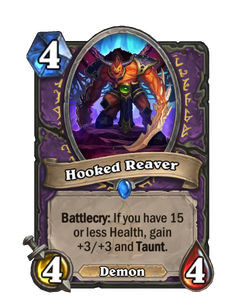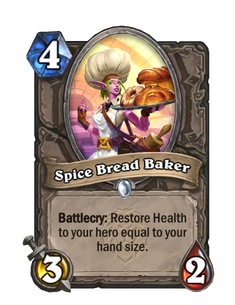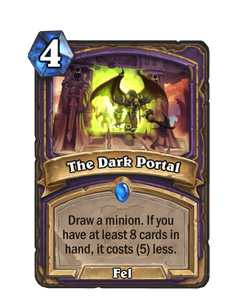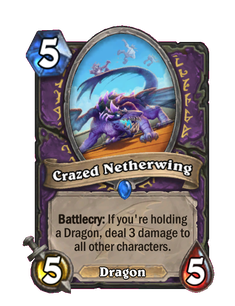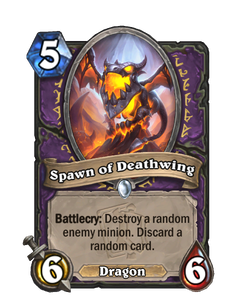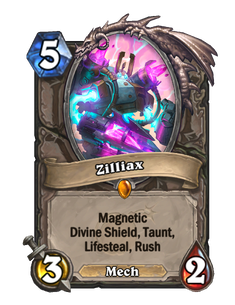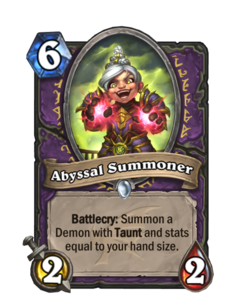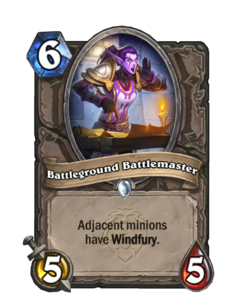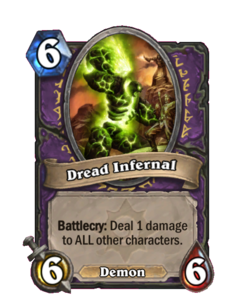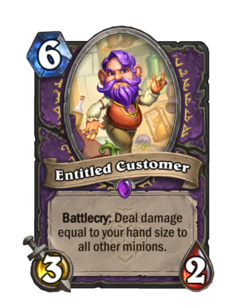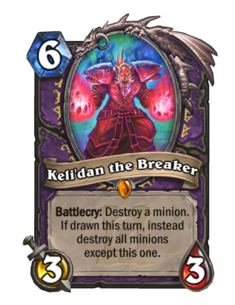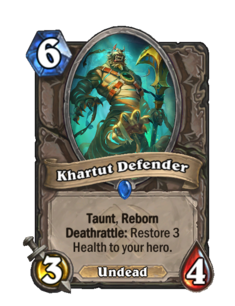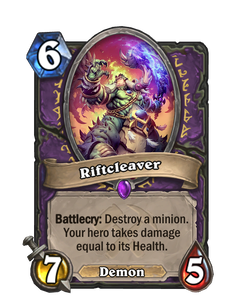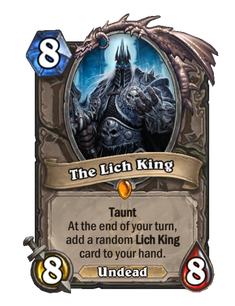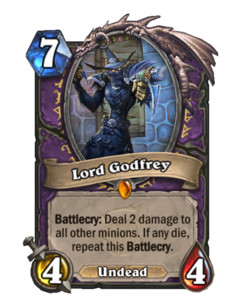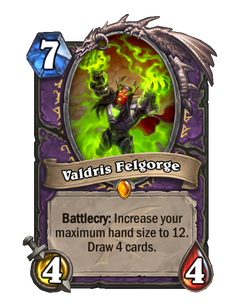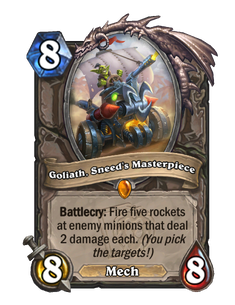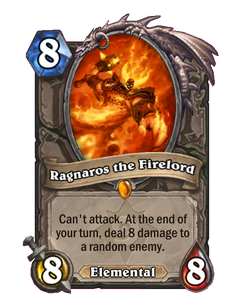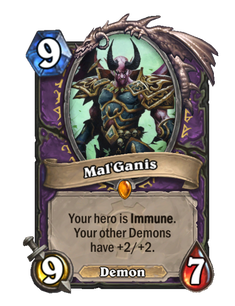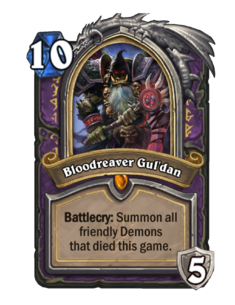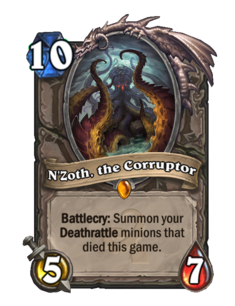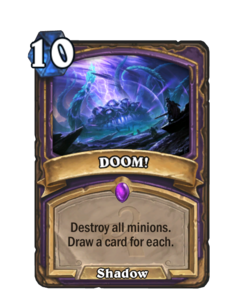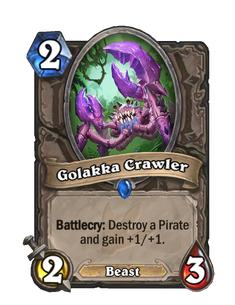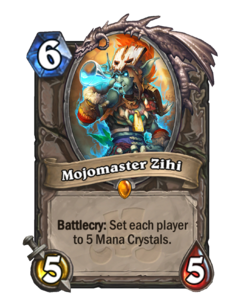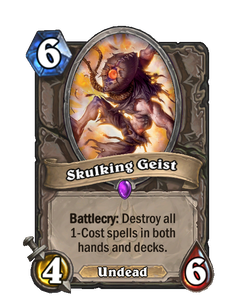Hearthstone Wiki:Archived/Handlock
They may also contain information that changes at such a rapid pace that maintaining them is no longer practical.
Handlock (also known as Hand Lock or previously Control Warlock, before the other control warlock decks existed) is a type of warlock control deck that commonly has a high number of cards in the hand, thus earning the name Handlock. Handlock uses synergy with high hand size and low Health to produce sudden and devastating board plays while keeping itself narrowly out of reach of defeat. Handlocks rely on Taunts, limited removal and good healing in order to stay alive long enough to play out a flurry of powerful minions, with which they then tend to very quickly overwhelm the opponent.
Due to many of Handlock's core cards being of even cost, ![]() Genn Greymane is often utilized in many Handlock decks, they are more commonly known as Evenlocks.
Genn Greymane is often utilized in many Handlock decks, they are more commonly known as Evenlocks.
With a dangerous relationship with Health and a range of possible strategies to employ at any moment, Handlock is widely considered one of the most complex decks in Hearthstone.
Deck type[edit source]
Over time, Handlock has developed vastly different playstyles between Standard and Wild. In Standard, Handlock aims to draw as many cards as possible in the early game to play Twilight Drakes and Abyssal Summoners. While Wild Handlock attempts the same, Wild Handlock also aims to deal self-damage through the hero power ![]() Life Tap, or through other cards such as
Life Tap, or through other cards such as ![]() Vulgar Homunculus and
Vulgar Homunculus and ![]() Hellfire. This is the defining difference between the Standard and Wild versions of Handlock.
Hellfire. This is the defining difference between the Standard and Wild versions of Handlock.
In Standard Handlock, health is rarely sacrificed for purposes other than drawing cards, as there are few viable healing and self-damage synergy cards in Standard. In the late game, Standard Handlock either uses ![]() Lord Jaraxxus or
Lord Jaraxxus or ![]() Arch-Villain Rafaam to apply more pressure, but Wild Handlock uses
Arch-Villain Rafaam to apply more pressure, but Wild Handlock uses ![]() Bloodreaver Gul'dan or even
Bloodreaver Gul'dan or even ![]() Ragnaros the Firelord.
Ragnaros the Firelord.
Wild Handlock has access to a large arsenal of healing cards such as ![]() Shroom Brewer and
Shroom Brewer and ![]() Plated Beetle in addition to self-damage synergy cards such as
Plated Beetle in addition to self-damage synergy cards such as ![]() Molten Giant and
Molten Giant and ![]() Hooked Reaver,
Hooked Reaver, ![]() Lesser Amethyst Spellstone fits into both of these categories.
Lesser Amethyst Spellstone fits into both of these categories.
Regardless of game format, drawing cards is still the prime objective of the deck. In the early game, Handlock tries to draw as many cards as possible, while playing cheap Mountain Giants and Twilight Drakes. Against aggro, said Mountain Giants and Twilight Drakes will be given Taunt with cards like ![]() Sunfury Protector and
Sunfury Protector and ![]() Defender of Argus. An establishment of large Taunt minions on the board likely results in defeat for the aggro deck. Against slower decks, Handlock wins through overwhelming the opponent with large minions in the early game where removal tools are less likely to be available. A swift defeat is also likely if the opponent does successfully remove the Handlock's threats, especially in Standard where Handlock has very few threats.
Defender of Argus. An establishment of large Taunt minions on the board likely results in defeat for the aggro deck. Against slower decks, Handlock wins through overwhelming the opponent with large minions in the early game where removal tools are less likely to be available. A swift defeat is also likely if the opponent does successfully remove the Handlock's threats, especially in Standard where Handlock has very few threats.
![]() Lord Jaraxxus is an optional Handlock card, best played after effecting a full board clear. Jaraxxus' weapon
Lord Jaraxxus is an optional Handlock card, best played after effecting a full board clear. Jaraxxus' weapon ![]() Blood Fury provides a good source of immediate damage, while
Blood Fury provides a good source of immediate damage, while ![]() INFERNO! provides a win condition if the Handlock is not quickly defeated.
INFERNO! provides a win condition if the Handlock is not quickly defeated.
Due to many core cards of Handlock being even-costed, ![]() Genn Greymane is often used for Handlock, and has become vastly more popular than the non-even version of Handlock in Wild. This variation of Handlock is known as Evenlock or Even Warlock. With the 1-cost
Genn Greymane is often used for Handlock, and has become vastly more popular than the non-even version of Handlock in Wild. This variation of Handlock is known as Evenlock or Even Warlock. With the 1-cost ![]() Life Tap, Evenlock can play a Mountain Giant as early as turn 3. Evenlock focuses on self-damage even more than earlier versions of Handlock, and uses Life Tap much more often.
Life Tap, Evenlock can play a Mountain Giant as early as turn 3. Evenlock focuses on self-damage even more than earlier versions of Handlock, and uses Life Tap much more often.
Counters[edit source]
Handlocks can be recognized early on by their tendency to use Life Tap each turn during the early game. While a Zoolock aims to open with a flurry of small synergistic minions, Handlocks aim to draw cards and build their hand size as quickly as possible, and are quite happy to take damage in the process, as this unlocks their Molten Giants and makes their healing cards worth playing. For this reason, many deck types intentionally avoid dealing damage to the Handlock during certain stages of the game, in order to prevent them from playing multiple Molten Giants in one turn, and thus presenting a problematic barrier to minion and weapon attack.
Defeating a Handlock usually happens by one of two means: either the Handlock is defeated very quickly, before they are able to lay down Taunts, or draw Molten Giants, healing or removal; or the opponent steadily dismantles their play by methodically countering their key cards. Once a Handlock's Giants have been removed, the majority of its power is spent, and defeating it becomes a far more achievable goal.
A third approach to defeating a Handlock involves burst damage. With enough damage in hand a player can directly destroy a Handlock mid-game, due to the Handlock's tendency to hover at middling Health; a hunter with 2 x ![]() Kill Command and a Beast in hand, or a mage with a combination of direct damage spells, can burst the warlock down in a single turn, overcoming the wall of Taunts that may be facing them. Given the Handlock's tendency to self-harm using Life Tap, it is sometimes possible to defeat Handlocks mid-game in this way without having dealt any damage to them prior to this point.
Kill Command and a Beast in hand, or a mage with a combination of direct damage spells, can burst the warlock down in a single turn, overcoming the wall of Taunts that may be facing them. Given the Handlock's tendency to self-harm using Life Tap, it is sometimes possible to defeat Handlocks mid-game in this way without having dealt any damage to them prior to this point.
Silences like ![]() Ironbeak Owl,
Ironbeak Owl, ![]() Earth Shock and
Earth Shock and ![]() Mass Dispel are excellent counters to the Handlock's wall of Taunts, providing extra damage to reach lethal, since the Handlock will often rely on their Taunts to prevent damage from a board of minions, rather than attempting to remove them directly. The Handlock's Taunts can also be traded for or removed individually, but the key Handlock gambit is that once in play the opponent will not be able to remove them all before the opponent either runs out of resources or is overrun.
Mass Dispel are excellent counters to the Handlock's wall of Taunts, providing extra damage to reach lethal, since the Handlock will often rely on their Taunts to prevent damage from a board of minions, rather than attempting to remove them directly. The Handlock's Taunts can also be traded for or removed individually, but the key Handlock gambit is that once in play the opponent will not be able to remove them all before the opponent either runs out of resources or is overrun.
The result of aggressive play against Handlocks is significantly affected by card draw, although many of the staple plays are fairly reliable responses. For example, an aggro deck may burst the Handlock down to 10 Health in the first few turns, only to have the Handlock play two Molten Giants and a Sunfury Protector, then heal themselves with an ![]() Earthen Ring Farseer, quickly going on to defeat the aggressor; while in another match this play could easily lead to a turn 5 victory. In other cases, a slower deck might tentatively reduce the Handlock's Health in order to avoid enabling its larger minions, only to discover that their hesitance has given the Handlock just the time it needed to locate its key cards.
Earthen Ring Farseer, quickly going on to defeat the aggressor; while in another match this play could easily lead to a turn 5 victory. In other cases, a slower deck might tentatively reduce the Handlock's Health in order to avoid enabling its larger minions, only to discover that their hesitance has given the Handlock just the time it needed to locate its key cards.
Whichever approach is taken, care should be taken to reserve burst to reach beyond the Handlock's healing and Taunt capabilities, since damaging the Handlock prematurely simply increases its range of options. Often it is best to reserve damaging spells until after physical attacks are thwarted since Handlock has no direct means of preventing defeat by such means.
Standard cards[edit source]
Core cards[edit source]
The following cards are played in most or all Standard versions of the deck:
Optional cards[edit source]
The following cards are played more than occasionally, but not always:
Wild cards[edit source]
In addition to Wild cards, this section also includes some Standard cards.
Core cards[edit source]
The following cards are played in most or all Wild versions of the deck:
Even build[edit source]
Even Highlander build[edit source]
- Main article: Renolock
Even Dragon build[edit source]
Optional cards[edit source]
The following cards are played more than occasionally, but not always:
Tech cards[edit source]
History[edit source]
Handlock has existed ever since Hearthstone was released. As many centerpieces of Handlock are in the Classic and Basic sets, Handlock was one of the most consistent and enduring decks in the pre-Naxx era. Considering that even a ![]() Chillwind Yeti on turn 4 was challenging to answer, a
Chillwind Yeti on turn 4 was challenging to answer, a ![]() Mountain Giant on the same turn was almost impossible to answer.
Mountain Giant on the same turn was almost impossible to answer.
With the release of the Curse of Naxxramas adventure, the prime aggro deck was reduced to just Undertaker Hunter. While slower decks received ![]() Sludge Belcher and
Sludge Belcher and ![]() Loatheb, Handlock under the Naxxramas meta was even stronger, as Miracle Rogue became less popular.
Loatheb, Handlock under the Naxxramas meta was even stronger, as Miracle Rogue became less popular.
The next few sets added few cards for Handlock, but it remained a valid competitive deck albeit getting weaker every expansion. With Whispers of the Old Gods and the Year of the Kraken rotation, many decks became weaker and some even completely unplayable in Standard. Due to the centerpieces of Handlock being in Basic and Classic, Handlock was among the least affected decks at the time. Additionally, ![]() Faceless Shambler was also released in Whispers of the Old Gods, one of the first important cards for Handlock released in any set other than Basic and Classic, further boosting the power of Handlock.
Faceless Shambler was also released in Whispers of the Old Gods, one of the first important cards for Handlock released in any set other than Basic and Classic, further boosting the power of Handlock.
As the Year of the Kraken progressed, Handlock became less and less of a competitive deck, due to the increasing variety of cheap removal tools, increasing use of cheap removal tools, and an increasing use and variety of burst damage. Warlock, in general, was extraordinarily weak in these metas. By the last expansion of the year, Mean Streets of Gadgetzan and with the release of Kaakus, Renolock completely overshadowed Handlock and Zoolock, becoming the only competitively viable Warlock deck in that meta.
Another rotation at the start of the Year of the Mammoth boosted Handlock's popularity again, but the popularity did not last. With Quest Rogue and Pirate Warrior popular, decks in the Journey to Un'goro meta either ensured victory before Handlock could play any of its threats or easily removed Handlock's threats. The Knights of the Frozen Throne meta followed the same pattern as Journey to Un'goro against Handlock. With a generally slower meta than metas for the last 3 expansions, Handlock still struggled, as Highlander Priest and Tempo Rogue would still have access to both cheap removal and high amounts of burst damage. Highlander Priest was especially efficient against Handlock, as the optimal health range for Handlock was just the optimal health range for Highlander Priest to kill opponents with ![]() Prophet Velen,
Prophet Velen, ![]() Voidform, and
Voidform, and ![]() Mind Blast.
Mind Blast.
Kobolds and Catacombs released extremely efficient Warlock cards. Handlock was still unpopular due to the rise of Cubelock. At the time, Cubelock was much more powerful and dominated the meta. Additionally, decks targeting Cubelock would also be effective against Handlock, which made a meta even less in favor of Handlock.
The Year of the Raven rotation did very little to Handlock, however, the expansion coming with the Year of the Raven, The Witchwood, brought a vastly impactful card for Handlock, ![]() Genn Greymane. Cubelock at the time was still vastly superior compared to Handlock, and as a result still was the dominant Warlock deck. With Patch 11.1.1.24589 bringing the nerfs to
Genn Greymane. Cubelock at the time was still vastly superior compared to Handlock, and as a result still was the dominant Warlock deck. With Patch 11.1.1.24589 bringing the nerfs to ![]() Dark Pact and
Dark Pact and ![]() Possessed Lackey, Cubelock finally became less dominant. Evenlock, the Handlock variant utilizing
Possessed Lackey, Cubelock finally became less dominant. Evenlock, the Handlock variant utilizing ![]() Genn Greymane, became the most effective Warlock deck and secured itself as an efficient and competitively viable deck. Utilizing many tools from expansions finally brought to Handlock, such as
Genn Greymane, became the most effective Warlock deck and secured itself as an efficient and competitively viable deck. Utilizing many tools from expansions finally brought to Handlock, such as ![]() Vulgar Homunculus, Lesser Amethyst Spelllstone, and
Vulgar Homunculus, Lesser Amethyst Spelllstone, and ![]() Hooked Reaver, Evenlock stayed consistent and powerful for the rest of the Year of the Raven. Evenlock was also immensely popular in Wild. Having access to
Hooked Reaver, Evenlock stayed consistent and powerful for the rest of the Year of the Raven. Evenlock was also immensely popular in Wild. Having access to ![]() Molten Giant and
Molten Giant and ![]() Faceless Shambler, Evenlock possessed many more threats than most previous versions of Handlock.
Faceless Shambler, Evenlock possessed many more threats than most previous versions of Handlock.
At the start of the Year of the Dragon, ![]() Genn Greymane was put into the Hall of Fame, making Evenlock a Wild-only deck. In Wild, this change had no effect on Evenlock, and the Evenlock remained as a popular deck in the Wild meta. In Standard, Handlock no longer had access to the important cards from the Year of the Mammoth, such as
Genn Greymane was put into the Hall of Fame, making Evenlock a Wild-only deck. In Wild, this change had no effect on Evenlock, and the Evenlock remained as a popular deck in the Wild meta. In Standard, Handlock no longer had access to the important cards from the Year of the Mammoth, such as ![]() Defile,
Defile, ![]() Hooked Reaver,
Hooked Reaver, ![]() Lesser Amethyst Spellstone, and
Lesser Amethyst Spellstone, and ![]() Bloodreaver Gul'dan. Initially, in Rise of Shadows, a version of Handlock closer to the pre-Naxx version of Handlock was tested, utilizing
Bloodreaver Gul'dan. Initially, in Rise of Shadows, a version of Handlock closer to the pre-Naxx version of Handlock was tested, utilizing ![]() Arch-Villain Rafaam as a finisher. It was then quickly discovered that even with only three expansions in Standard, all widely considered to be weak, Handlock still was not viable. No viable self-damage synergy cards remained in Standard accessible to Warlock, as
Arch-Villain Rafaam as a finisher. It was then quickly discovered that even with only three expansions in Standard, all widely considered to be weak, Handlock still was not viable. No viable self-damage synergy cards remained in Standard accessible to Warlock, as ![]() Molten Giant was rotated into Wild at the start of the Year of the Raven.
Molten Giant was rotated into Wild at the start of the Year of the Raven.
Handlock remained largely absent during the Year of the Dragon meta with the rotation of many powerful late-game cards. The release of Saviors of Uldum brought cards viable in Handlock, specifically ![]() Riftcleaver and
Riftcleaver and ![]() Expired Merchant, but these cards were not enough to make Standard Handlock a viable deck, and only made Evenlock in Wild more powerful. However, Descent of Dragons brought Handlock back into the spotlight with a handful of hand-size synergy cards like
Expired Merchant, but these cards were not enough to make Standard Handlock a viable deck, and only made Evenlock in Wild more powerful. However, Descent of Dragons brought Handlock back into the spotlight with a handful of hand-size synergy cards like ![]() Dark Skies,
Dark Skies, ![]() Abyssal Summoner, and
Abyssal Summoner, and ![]() Valdris Felgorge, as well as powerful mid-game dragon like
Valdris Felgorge, as well as powerful mid-game dragon like ![]() Crazed Netherwing and
Crazed Netherwing and ![]() Zzeraku the Warped.
Zzeraku the Warped.
In the Year of the Phoenix, ![]() Mountain Giant was rotated to the Hall of Fame, removing yet another key component of the deck. While new hand synergy cards like
Mountain Giant was rotated to the Hall of Fame, removing yet another key component of the deck. While new hand synergy cards like ![]() The Dark Portal,
The Dark Portal, ![]() Shadow Council, and
Shadow Council, and ![]() Imprisoned Scrap Imp were printed in Ashes of Outland, the deck was less powerful than Galakrond Control Warlock, and fell by the wayside yet again.
Imprisoned Scrap Imp were printed in Ashes of Outland, the deck was less powerful than Galakrond Control Warlock, and fell by the wayside yet again.
External links[edit source]
- Hearthpwn.com - Handlock decks
- Reddit - Quick Beginner's Guide to Handlock
- Trump Deck Teachings - 11 - Handlock (Warlock)

